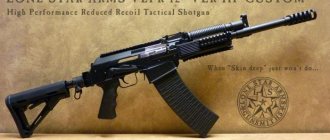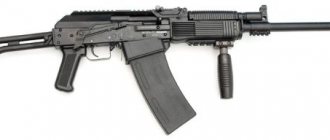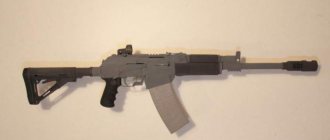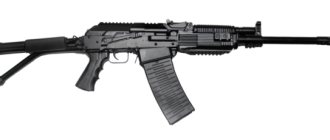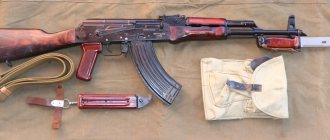Self-loading carbine Molot VPO-185 (Russia)
The Molot VPO-185 self-loading carbine was first announced in 2022, and at the beginning of 2022 its retail sales began on the Russian market. The VPO-185 carbine was developed by Molot Oruzhie LLC from the city of Vyatskie Polyany and is intended mainly for sports and recreational shooting or home defense. It is expected that in the future there will be a version of this carbine specially optimized for sports (practical shooting in the “carbine chambered for a pistol cartridge” category). Another option is the VPO-285 carbine chambered for the 9x22 Altay cartridge, but there is no information yet about the timing of its release. Initially, the VPO-185 carbine was positioned by the manufacturer as a cheaper alternative to the 9mm Saiga-9 carbine, but at the time of the start of sales, the retail price of the new carbine was quite comparable to the price of the Saiga-9. The possibility of “customizing” the new model also raises questions, primarily the installation of alternative stock options.
Self-loading carbine Molot VPO-185
The Molot VPO-185 self-loading carbine uses blowback automatic action. Shooting is carried out from a closed bolt, the firing mechanism is trigger, similar to the VPO carbines based on the Kalashnikov system. The bolt group has a rather complex design and consists of 5 parts, including an adjustable cocking handle. The receiver is made of aluminum alloy; the trigger mechanism housing, made of plastic, is attached to it from below using one transverse pin. To disassemble the weapon, you must first separate the trigger housing and then remove the recoil spring guide, held in the receiver by two transverse pins. After this, you can remove the bolt group from the receiver piece by piece.
Self-loading carbine Molot VPO-185
The carbine is equipped with ambidextrous manual safety levers located above the pistol grip. The stock is telescopic, retractable, without the ability to adjust the length. In the folded (retracted) position, the butt rods block the safety in the on position, preventing it from being turned off, in order to comply with the requirements of the Russian Federation weapons law. The carbine does not have mechanical sights as standard. Optical, mechanical or red dot sights can be installed at the user's discretion on the Picatinny rail on the receiver. The muzzle of the barrel has a thread protected by a removable sleeve. The cartridges are fed from detachable box magazines compatible with Kalashnikov Saiga-9 carbines. The VPO-185 carbine is standardly equipped with one magazine with a capacity of 10 rounds.
| Characteristic | Meaning |
| Chuck used | 9x19 Luger/Parabellum |
| Automation type | self-loading |
| USM type | sa |
| Length, mm | 817 |
| Length with stock folded, mm | 548 |
| Barrel length, mm | 305 |
| Weight without cartridges, kg | 2,6 |
| Magazine capacity, cartridges | 10, 20, 30 |
Hammer Passion
photo: Semina Mikhail
There are three stable names: “Hammer Weapons” and “Hammer Arms” - for the majority of those who have little interest in the issue of weapons production, all this is “Hammer”, but this is not so.
is an enterprise that arose during the Second World War, a plant that moved from near Moscow, built in an open field and mass-produced PPSh. After the war, it produced mainly machine guns, as well as household appliances and even scooters.
After restructuring and conversion, this plant developed, produced and produces hunting rifles of the Bekas series and carbines of the Vepr series, and was also noted for the conversion of military weapons into civilian weapons, a range of VPO-133, 136 carbines, etc., and the production of trauma equipment based on APS – VPO-504 (APS-M) and TT – VPO-509 (Leader-M).
The plant's products have always been distinguished by their strength, durability and reliability. A good demonstration of factories would be the phrase of the hero from the movie “Snatch”: “Weight is good, weight is reliability; if it doesn’t shoot, you can always hit them in the head,” but, unlike in the movies, the product is not only heavy, but also shoots great.
Hammer Weapon LLC is a subsidiary that is engaged in retail and wholesale sales of its products, that is, essentially the same thing. But this is not a factory at all; the confusion, as I understand it, arose not only because of the similarity of the name, but also because the last enterprise is located in the same place as the plant, in the city of Vyatskie Polyany.
The enterprise itself in terms of size, manpower and resources cannot be compared with the plant, it is a small private enterprise that stood out for developing extremely interesting models, it was they who were able to bring into series the MA-136S - a hunting carbine very similar to the AKS, that the same folding down stock, PPSh-Luger - hunting carbine based on PPSh for caliber 9x19, carbines based on PPD, "Maxim", PPS. In fact, the plant is engaged in reworking and adapting various types of weapons for the civilian market.
This happens with varying degrees of success, sometimes very successfully, sometimes not, and the quality periodically suffers.
But, in general, the enterprise is interesting and worthy, with designers who think outside the box, for which we thank them.
At the beginning of the year, these two fellow countrymen enterprises entered into a confrontation over the name "Hammer". The plant does not want its products to be associated with the products of Molot Arms LLC and requires it to change its name. Probably, the plant is right in some ways, but it would be nice to make such statements when the “MA” brand was unfamiliar or completely unknown; today, when it has been quite successfully promoted for several years, this is not entirely correct.
It is not clear why, several years later, given the long-standing ties between these enterprises, this conflict arose today, because many MA samples were based on products specifically. Let's hope that the problem will be resolved and both enterprises will delight us with their products.
Alexander Kudryashov November 12, 2015 at 12:48 pm
From PPSh to "Vepr". History of the Vyatsko-Polyansky machine-building plant "Molot"
“Molot” is mentioned on the pages of the magazine in almost every issue, and our readers have already become acquainted with the civilian products produced by the company - these are OF-93, pump-action shotguns of the “Bekas” series, carbines “Vepr”, “Vepr-308”, “Vepr” -308 Super.” But for more than half a century the plant worked for defense, and few people know how wide the range of army products was.
The city of Vyatskie Polyany is located in the Kirov region on the picturesque banks of the Vyatka River. Not every Russian can confidently point it out on the map, but, without exaggeration, the whole world knows the products of the Vyatsko-Polyansky Machine-Building Plant.
In any, even the most insignificant military conflict in both hemispheres, the VPMZ “Hammer” weapon was certainly used.
The history of the city and the plant began back in 1941. The failures of the Red Army in the first year of the Great Patriotic War required the evacuation of the main plant for the production of 7.62 mm PPSh submachine guns from Zagorsk near Moscow to the working village of Vyatskie Polyany. They placed it at the local bobbin factory. This has never happened before in world practice - the break in the work of the plant was only 30 days, and in the production of finished products - 45! The evacuation of the plant had a beneficial effect on the development of the infrastructure of the workers' village, and already in 1942 Vyatskie Polyany acquired the status of a city. Throughout the war, the machine-building plant remained the leading enterprise for the production of PPSh (out of 5 million PPSh produced by all enterprises of the People's Commissariat of Armaments, the Vyatsko-Polyansky Machine-Building Plant produced 2.3 million).
The creator of the PPSh G. S. Shpagin (1897–1952) and the house in which G. S. Shpagin lived (now it houses the museum of the outstanding designer)
Since 1943, the plant has produced the 26-mm signal pistol OPSh (later on - the signal pistol Shpagin - SPSh model 1944), which is still used in the Russian army, geologists, environmental agencies, etc.
The factory keeps an interesting experimental copy of a pistol with an inertial recoil damping mechanism. This sample was not mass-produced and is preserved in a single copy.
The selfless work of the plant staff (at that time No. 367) did not go unnoticed; on September 16, 1945, he was awarded the highest award of the USSR - the Order of Lenin. In the post-war years, Molot remained in the ranks of defense enterprises, producing the most advanced products.
In 1950, production of 40-mm VG-44 mortars for the 7.62-mm carbine mod. 1944 and VG-45 for the 7.62-mm SKS carbine for firing fragmentation and cumulative grenades. From 1953 to 1955 "Molot" was the only manufacturer of the 9-mm Stechkin automatic pistol in the country. Starting from 1959 and the next 25 years, the Vyatsko-Polyansky Machine-Building Plant produced all modifications of the RPK light machine gun.
Signal pistol designed by Shpagin mod. 1944 and an experimental copy of the SPS with an inertial recoil damping mechanism
7.62 mm submachine gun mod. 1941 PPSh-41
5.45-mm modernized Kalashnikov RPK74M light machine gun
Automatic Stechkin pistol (APS) with an attached holster-butt
12.7-mm machine gun NSV-12.7 "Utyos" on a machine manufactured by VPMZ "Molot"
In 1970, production of the world's first mass-produced 30-mm automatic grenade launcher AGS-17, which is produced to this day in various modifications, was mastered. In 1971, a silent firing device was produced and APS pistols were converted into APB. In 1974, a 5.45 mm RPK74 light machine gun of all modifications, infantry (ind. 6T7) and universal (ind. 6U6) machines for the 12.7 mm NSV-12.7 machine gun were put into production. For more than 30 years, Molot has been a monopolist in the production of machines for equipping machine gun belts of all modifications.
30-mm automatic mounted grenade launcher AGS-17 “Flame”
In addition to the production of small arms, the Vyatsko-Polyansky Machine-Building Plant produces launchers for launching illumination shells, turret-mounted grenade launchers, rocket-propelled infantry flamethrowers, etc.
During the period of reduction of the Russian army, due to a decrease in orders from the Ministry of Defense, Molot established the production of civilian and service weapons, while the quality of the products remained at the traditional high level for Molot. In addition to the well-known hunting carbines of the Vepr series and Bekas shotguns, the plant has many interesting developments that played a significant role in the formation of the modern style of civilian weapons "Molot".
At the very beginning of the 90s, specialists from TsNIITOCHMASH (Podolsk) approached the Vyatsko-Polyansky Machine-Building Plant with a proposal to produce a small batch of 16-gauge pump-action shotguns.
“Molot” coped with the task and produced about 20 products. One of the first pump-action shotguns in Russia was based on the KS-23 pump-action carbine of the 4th caliber (23 mm). Moreover, the gun was designed for a very low-power 16-gauge cartridge with a cartridge case length of only 35 mm. It was the work on preparing for the production of the “Podolsk miracle” that prompted the factory designers to develop an ordinary 16-caliber pump-action shotgun. True, the first step was made relying on the same 16x35 mm cartridge. But only the first one. Almost immediately, the gun was converted to a 16-gauge cartridge with a long 70 mm cartridge case, and it was this that marked the beginning of the Bekasov family. Smoothbore service revolver DOG-1
In general, the developers have always sought to be friends with Molot, as an enterprise capable of ensuring mass production of high-quality weapons.
As a result of cooperation with one of the Izhevsk companies, the plant began production of the DOG-1 smooth-bore service revolver. During the production process, based on the revolver, the factory workers developed an interesting system for launching signal flares. The signaling device was “killed” by the ECC of the Ministry of Internal Affairs of the Russian Federation, believing that craftsmen would be able to convert it into a firearm. The “Spider” pistol (in the foreground) was developed for the 9x19 cartridge on the basis of the Stechkin APS automatic pistol (in the background).
As a result of cooperation between Vyatskiye Polyany and Tula residents, the once sensational “farmer’s weapon” OF-93 appeared, which could shoot not only shot and a bullet, but also flying syringes ShL-28.
Molot has gas pistols and revolvers, devices for shooting hunter signals, and much more.
The latest innovations include Safari carbines. The “Spider” was developed on the basis of the Stechkin automatic pistol and differs from it in the presence of a gas brake for recoil. The device is located under the barrel, in the same place as the return spring, which in the APS is put on the barrel. The complexity of the device is determined by the use of a more powerful, compared to 9x18 PM, 9x19 Para cartridge, which made the use of a blowback system difficult.
The roots of the idea of creating pump action carbines "Safari" go back to Australia. Oddly enough, hunting with self-loading rifled carbines is prohibited in a distant country, and Australians treat the Kalashnikov system with great respect. The result of consultations with specialists from the green continent was the start of work on a repeating carbine with reloading with a movable fore-end. Now two versions of “Safari” are ready, which are shown in the illustrations for this article.
Two versions of the experimental "Safari" carbine with reloading with a movable fore-end. The samples were developed specifically for the Australian market, where hunting with self-loading carbines is prohibited
It was these pump-action shotguns chambered for 16x35, created on the basis of the KS-23, that pushed the Vyatka-Polyansky designers to develop a pump-action shotgun, now known as “Bekas.”
For decades, the Molot team honed its skills on military products. Now the experience of designers, technologists, workers of all specialties is used in the manufacture of not only hunting weapons, but also a wide range of consumer goods. Woodworking machines, automatic packaging lines, Strizh scooters, side trailers for Izhevsk motorcycles, fuel cans, microwave ovens and many other useful things are produced by Molot. And all products are distinguished by ease of use, quality workmanship and unsurpassed reliability.
Administrative building of the Vyatsko-Polyansky machine-building plant
Vyatskie-Polyany
Vyatskie-Polyany are located in the most picturesque places in the very center of our country. There is still plenty of game in the local forests, and fishermen have something to profit from in the Vyatka River. - the only large enterprise in the city, which is tens of times smaller than the generally recognized weapons capitals - Izhevsk and Tula. And it was thanks to “Hammer” that the small town became known on all continents as a forge of Russian weapons...
Yuri Ponomarev Kalashnikov 4-2000
